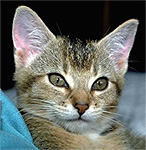 | How Much Do Animals Sleep? |  |
 | How Much Do Animals Sleep? |  |
| Species | Average Total Sleep Time (% of 24 hr) |
Average Total Sleep Time (Hours/day) |
|---|---|---|
| Brown Bat | 82.9% | 19.9 hr |
| North American Opossum | 81% | 19.4 hr |
| Giant Armadillo | 75.4% | 18.1 hr |
| Python | 75% | 18 hr |
| Owl Monkey | 70.8% | 17.0 hr |
| Bottle-nosed dolphin | 16.7% | 4.0 hr |
| Human (infant) | 66.7% | 16 hr |
| Tiger | 65.8% | 15.8 hr |
| Tree shrew | 65.8% | 15.8 hr |
| Squirrel | 62% | 14.9 hr |
| Western Toad | 60.8% | 14.6 hr |
| Ferret | 60.4% | 14.5 hr |
| Three-toed Sloth | 60% | 14.4 hr |
| Golden Hamster | 59.6% | 14.3 hr |
| Platypus | 58.3% | 14.0 hr |
| Lion | 56.3% | 13.5 hr |
| Gerbil | 54.4% | 13.1 hr |
| Rat | 52.4% | 12.6 hr |
| Cat | 50.6% | 12.1 hr |
| Cheetah | 50.6% | 12.1 hr |
| Mouse | 50.3% | 12.1 hr |
| Rhesus Monkey | 49.2% | 11.8 hr |
| Chicken | 48.8% | 11.7 hr |
| Jaguar | 45% | 10.8 hr |
| Duck | 45% | 10.8 hr |
| Dog | 44.3% | 10.6 hr |
| Star-nosed Mole | 42.9% | 10.3 hr |
| Baboon | 42.9% | 10.3 hr |
| European Hedgehog | 42.2% | 10.1 hr |
| Squirrel Monkey | 41.3% | 9.9 hr |
| Fox | 40.6% | 9.75 hr |
| Chimpanzee | 40.4% | 9.7 hr |
| Guinea Pig | 39.2% | 9.4 hr |
| Rabbit | 36% | 8.4 hr |
| Ostrich | 33.3% | 8 hr |
| Human (adult) | 33.3% | 8 hr |
| Pig | 32.6% | 7.8 hr |
| Guppy (fish) | 29.1% | 7 hr |
| Gray Seal | 25.8% | 6.2 hr |
| Sheep | 24.6% | 5.9 hr |
| Human (elderly) | 22.9% | 5.5 hr |
| Goat | 22.1% | 5.3 hr |
| African Elephant (captive) | 16.6%-20.8% | 4-5 hr |
| Giraffe | 18.8% | 4.5 hr |
| Cow | 16.4% | 3.9 hr |
| Asiatic Elephant | 16.4% | 3.9 hr |
| Donkey | 13.0% | 3.1 hr |
| Horse | 12.0% | 2.9 hr |
| African Elephant (wild) | 8.8% | 2.1 hr |
References: This table was adapted from five sources:

Did you know? | The brain of a dolphin appears to sleep one hemisphere at a time. |

| BACK TO: | Exploring the Nervous System | Table of Contents |
![[email]](./gif/menue.gif) Send E-mail |
 Get Newsletter |
 Search Pages |